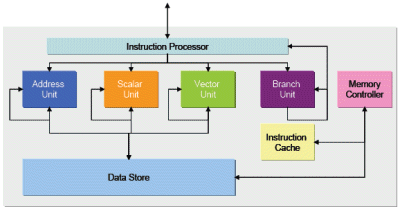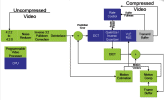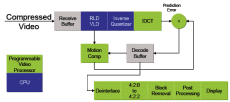Video ProcessorWith each generation of graphics processors we see more support for video processing built in - in some cases this is achieved through dedicated logic and, more recently in the case of ATI, some has been achieved via programmable shaders. With the likes of Windows Media Center and newer, high definition formats needing support, the role of the graphics processor is becoming increasingly important in order to keep CPU utilisation to a minimum. To address the ever more demanding needs of video processing, NVIDIA will introduce the Programmable Video Processor (VP) to the whole of the NV4x line.
The VP is a quad issue, integer processor designed for the tasks required for video processing. The Vector unit in the comprises of a 16-way SIMD vector unit.
The above diagram show the split between the CPU and VP for MPEG2 encoding an decoding. Being a programmable unit NVIDIA have already identified numerous formats and tasks that the engine can be applied to, though not all are coded yet - as time goes by they will develop new codecs and routines that will be supplied in the driver updates and will replace the codecs already installed such that applications will automatically make use of the newly programmed video formats. While ATI have been mapping some of their video processing over the Shader Core for some time NVIDIA have decided not to do this as they feel instructions required for video processing do not lend themselves well to the instruction set in the pixel shader pipeline; thus a dedicated unit may be more optimal for this type of work. When running video processing though the shaders this means the 3D core is active and consuming power as well, which may not be desirable in all situations, especially where mobile devices are concerned - the NV4x VP is a smaller unit dedicated to video processing so it should require less power for video processing than utilising the shader core. This is not to say, however, that NVIDIA won't utilise the shader core in conjunction with the VP in some instance, should they choose to do so. As with most processors, the performance, and hence capabilities, of a unit such as this will be heavily dependant on clock speed. The NV4x line will span numerous parts and numerous clock speeds, yet the VP engines clock can operate at a different frequency from the rest of the chip, which may mean that the VP in the slower NV4x models could have the same performance as the high performance NV4x parts. |
NV40 - GeForce 6800 Ultra Review - Page 13
Published on 14th Apr 2004, written by Dave Baumann for Consumer Graphics - Last updated: 20th Jul 2007



